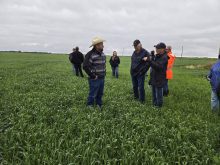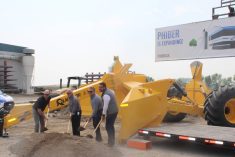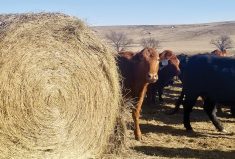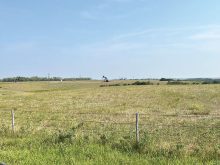It rains. Then it pours. Now, will it freeze?
With weather watchers raising the possibility of frost this week, Manitoba farmers are struggling to get harvestable crops into the bin — wet or dry — and keeping their fingers crossed later crops such as corn and soybeans will reach maturity in time.
Many hay producers in the province are still trying to gather up enough supplies for winter, the president of the Manitoba Forage and Grasslands Association says.
“I think we’re looking at pretty tight stocks,” said Jim Lintott. “We came into the summer having had no hay inventory for basically two winters… we finished off the winter and there was just no inventory left. That’s been the struggle for two years in a row.”
Read Also

Mazergroup’s Bob Mazer dies
Mazergroup’s Bob Mazer, who helped grow his family’s company into a string of farm equipment dealerships and the main dealer for New Holland machinery in Saskatchewan and Manitoba, died July 6 from cancer.
That means all the feed producers will need this winter will have to come from this summer’s production, he added.
In years past, a farmer who was short on hay could turn to a neighbour, but not anymore.
“The same is true for your neighbours… everybody is tight to start with, everybody is tight in terms of average, then you have the weather on top of it,” Lintott said.
Because of the wet conditions, many forage producers turned to making silage, instead of putting up dry hay.
“We still want to make dry hay whenever we can because it’s cheaper to make, particularly with the second cut,” he said. “There’s more cost involved with silage, but then it reduces the risk substantially when you go to a silage program, whether it’s chopped or round bales.”
Some forage producers were able to get a second cut off during a stretch of dry weather in early August, but those whose forage wasn’t ready to cut during the brief window lost out, said Lintott.
Forage producers are not alone in their water troubles, however.
“It’s definitely affecting everybody,” said Bill Ross, general manager of the Manitoba Canola Growers Association. “We’ve had too much rain, and out west they’ve had even more rain than the rest of us.”
What is getting harvested isn’t coming in dry, he added.
“Producers are still able to get out on the land, and there’s been some canola swathed and I’ve seen some cereals done, but it can’t be coming off dry. I’m positive they’re being dried,” he said. “But if we keep getting more rain, guys are going to have trouble getting on the land at all.”
The result is farmers are left trying to balance options, said Pam de Rocquigny, a business development specialist with Manitoba’s Department of Agriculture. Some are opting to harvest crops that are still too wet and dry them once they’re off the field.
“Of course there is going to be an extra cost if they are putting it through a dryer,” de Rocquigny said. “But at the same time they’re weighing what the potential losses could be if they have a downgraded quality due to weathering losses or something like that, so you’re weighing if you can leave it out there. Is it getting too mature, am I going to have losses due to shattering or something like that… or can I take it off at a little bit higher moisture content and then do something about it?”
But there is one big difference between forage crops and cereal or oilseed crops when it comes to excess moisture.
The vast majority of cereal and oilseed producers insure their crops, while uptake on the newly available forage insurance has been minimal, said Lintott.
“Crop insurance on grains and oilseeds has about 95, 98 per cent sign-up, everybody buys crop insurance for those annual crops, but it has only been from six to 16 per cent on forages,” he said. “As a rule, we do not think there is enough risk with growing forages to insure them, but if you actually look at the amount of investment… the amount of nutrients you’re removing from your soil that has to somehow be replaced, forages are actually quite expensive and you need to look closely at your risk management needs.”



















